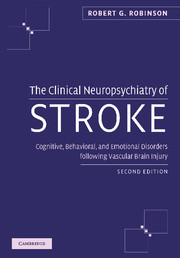 The Clinical Neuropsychiatry of Stroke
The Clinical Neuropsychiatry of Stroke Book contents
- Frontmatter
- Contents
- Preface
- Part I Introduction
- Part II Poststroke depression
- 5 Diagnosis of depression
- 6 Prevalence of depressive disorders
- 7 Phenomenology and specificity of depressive symptoms
- 8 Natural course of depression
- 9 Delayed-onset depression
- 10 Relationship to lesion location
- 11 Relationship of depression to cerebral dominance and structural asymmetries
- 12 Relationship of depression to bilateral hemisphere brain injury
- 13 Relationship of depression to physical impairment
- 14 Relationship to cognitive impairment and treatment
- 15 Relationship of aphasia to depression
- 16 Relationship of depression to social functioning
- 17 Relationship to premorbid risk factors
- 18 Mortality and treatment
- 19 Suicidal thoughts and plans
- 20 Biological markers
- 21 Mechanisms of poststroke depression
- 22 Treatment of poststroke depression
- 23 Prevention of poststroke depression
- Part III Poststroke mania
- Part IV Poststroke anxiety disorders
- Part V Other poststroke disorders
- Index
8 - Natural course of depression
from Part II - Poststroke depression
Published online by Cambridge University Press: 01 October 2009
- Frontmatter
- Contents
- Preface
- Part I Introduction
- Part II Poststroke depression
- 5 Diagnosis of depression
- 6 Prevalence of depressive disorders
- 7 Phenomenology and specificity of depressive symptoms
- 8 Natural course of depression
- 9 Delayed-onset depression
- 10 Relationship to lesion location
- 11 Relationship of depression to cerebral dominance and structural asymmetries
- 12 Relationship of depression to bilateral hemisphere brain injury
- 13 Relationship of depression to physical impairment
- 14 Relationship to cognitive impairment and treatment
- 15 Relationship of aphasia to depression
- 16 Relationship of depression to social functioning
- 17 Relationship to premorbid risk factors
- 18 Mortality and treatment
- 19 Suicidal thoughts and plans
- 20 Biological markers
- 21 Mechanisms of poststroke depression
- 22 Treatment of poststroke depression
- 23 Prevention of poststroke depression
- Part III Poststroke mania
- Part IV Poststroke anxiety disorders
- Part V Other poststroke disorders
- Index
Summary
Given the number of effective treatments that are available for poststroke depression (see Chapter 20), it is increasingly difficult to conduct studies on the natural course of this disorder. Several studies, however, were conducted prior to publication of the current treatment studies. In addition, most of these pretreatment studies examined the course of poststroke depression in the setting of “usual care.” Thus, in these studies, a minority of patients were treated with antidepressants by their primary care physician. Since effective treatment, however, must produce more rapid improvement of symptoms than would naturally occur over time, it is essential to study the natural course of poststroke depressive disorders. Our data on the natural course of depressive disorder is based on longitudinal studies in which patients received “usual care” and the vast majority were not given antidepressant treatment. We have studied the natural course of poststroke depression in two studies and several other groups have conducted similar investigations (Morris et al. 1990; House et al. 1991; Astrom et al. 1993a; Burvill et al. 1995; Pohjasvaara et al. 2001).
Our first longitudinal study of acute stroke patients was reported in 1983 (Robinson et al. 1983). A consecutive series of 103 patients admitted to the hospital with acute stroke, and diagnosed for depression using diagnostic and statistical manual (DSM-III) criteria were prospectively studied over a 2-year period.
- Type
- Chapter
- Information
- The Clinical Neuropsychiatry of StrokeCognitive, Behavioral and Emotional Disorders following Vascular Brain Injury, pp. 75 - 81Publisher: Cambridge University PressPrint publication year: 2006


